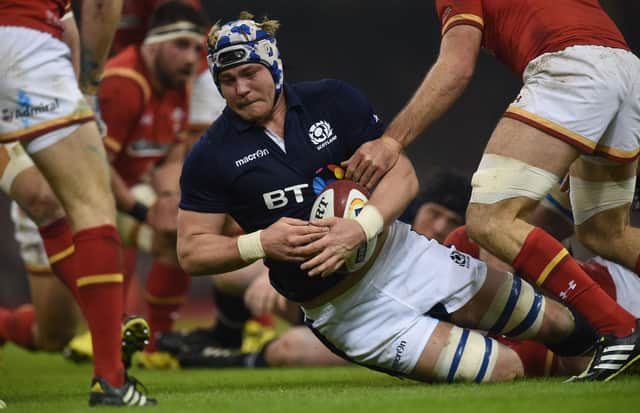World Rugby insists progress has been made in protecting players from injury


World Rugby has defended its record on protecting players after the authors of a study investigating injury levels in retired participants called for more to be done.
Researchers led by Durham University’s sport and exercise scientists said both union and league codes should step up efforts to prevent recurrent injuries and do more to help former players.
Advertisement
Hide AdAdvertisement
Hide AdThe study found concussion was the most common injury among players, with back pain and knee ligament damage also frequently reported.
Osteoarthritis was twice as common among elite rugby players compared to athletes playing non-contact sports, the study found.
World Rugby, rugby union’s governing body, said it welcomed the research which was published in the academic journal Sports Medicine.
But its chief medical officer Dr Eanna Falvey said improvements have been made to the sport since the playing days of many of the retired players who were surveyed.
He said: “These advances have led to a stabilisation of injury rates over the last decade and critically a year-on-year reduction in concussion rates from 2017.
“Taking Rugby World Cup 2019 as an example, the overall injury incidence was reduced from 2015 and the concussion rate was reduced by 28 per cent, which reflects our ongoing commitment to protecting our players at all levels.
“Injury prevention programmes such as Activate and Rugby Ready and robust training load management (understanding that different players have different injury risk profiles) will also have a potentially significant beneficial impact on these long-term health impacts.”
Report author Dr Karen Hind from the Department of Sport and Exercise Sciences at Durham University had suggested reducing the number of players on the pitch to decrease the number of collisions.
Advertisement
Hide AdAdvertisement
Hide AdBut World Rugby said research showed the highest injury rates were found in Sevens – the form of the game with the fewest numbers on the pitch. It said it was “not true” to say the Rugby World Cup in Japan saw a number of issues with high tackles and dangerous play leading to injuries, as it recorded the lowest number of injuries per 1,000 player hours of any modern World Cup.
The Durham University study found that most players suffer at least one concussion incident during their career.
The survey also found both elite and amateur ex-players reporting back pain and severe and regular joint pain, which they blamed on the long-term impact of cumulative injury.
About half of all players had sustained a knee ligament injury, with one in four still experiencing problems.
Project leader Dr Hind said: “It is clear from these findings that playing rugby union or rugby league is associated with lasting impacts in terms of injury and pain.
“Although there have been initiatives and rule changes to try and make the game safer, the rates of injury across a player’s entire career are still very high.
“The game is now also faster and players are bigger than they used to be so the impacts are greater.
“Many of the ex-players who took part in this study competed in rugby football over a decade ago when the sport was more about evasion.
Advertisement
Hide AdAdvertisement
Hide Ad“The injury levels for these individuals are up to nine-fold higher than for former non-contact athletes of a similar age. What we need to consider is that the game today is more about players running through opponents rather than evading – this is inevitably going to increase injury risk.”
The study was done in collaboration with academics from Auckland University of Technology in New Zealand.
It compared the types and number of injuries suffered by 254 male elite rugby players, amateur rugby players and non-contact athletes, such as cricketers.
The retired athletes ranged in age from 21 to 82 years.
Dr Hind added: “Our study looked at the total number of injuries across a player’s career and our findings suggest a need for better injury recovery given the reported frequency of recurrent injuries.
“A case could be argued for less players on the pitch and providing more opportunity for evasion.
“Medics also have a role to play in encouraging sensible injury recovery times which clubs need to support.
“Importantly, our findings highlight a need for programmes to support professional players post-retirement, in managing the long term impacts of injuries sustained during their career.”
Former England international Jon Sleightholme, who was part of the 1996 Five Nations winning team, said sometimes symptoms did not appear for years after retirement.
Advertisement
Hide AdAdvertisement
Hide AdHe said: “What the study highlights for me is the need for long-term support and education for ex-players to help them manage these conditions as they get older.”
A message from the Editor:
Thank you for reading this story on our website. While I have your attention, I also have an important request to make of you.
With the coronavirus lockdown having a major impact on many of our advertisers - and consequently the revenue we receive - we are more reliant than ever on you taking out a digital subscription.
Subscribe to scotsman.com and enjoy unlimited access to Scottish news and information online and on our app. With a digital subscription, you can read more than 5 articles, see fewer ads, enjoy faster load times, and get access to exclusive newsletters and content. Visit https://www.scotsman.com/subscriptions now to sign up.
Our journalism costs money and we rely on advertising, print and digital revenues to help to support them. By supporting us, we are able to support you in providing trusted, fact-checked content for this website.
Joy Yates
Editorial Director
Comments
Want to join the conversation? Please or to comment on this article.